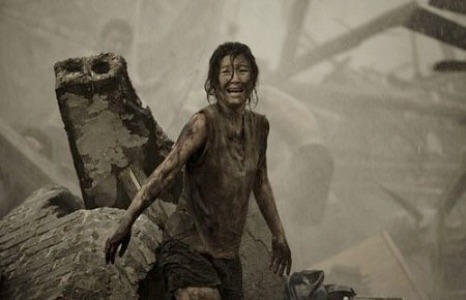
With over 300 titles from over 80 countries of the world being screened at the 2010 Toronto International Film Festival last month, it would have been impossible to see all the more important films. But squeezing 40 of them in 10 days was not a bad accomplishment. Here are some of the remaining titles in my final report from the festival that I would highly recommend for those seeking relevant films for the progressive community. (See my earlier reports here, here, here, here and here.)
The highest grossing film in Chinese history, “Aftershock” is a thrilling disaster movie about the real earthquakes that shook the city of Tangshan in 1976 and Sichuan in 2006. The Chinese ability to gather the masses to create amazing works of art is mindboggling in this unbelievably moving recreation of the tragedy. The personal story that follows one family through the tragedy is heartbreaking and gripping. Special effects, acting, music and cinematography are stunning in this first big IMAX movie created outside of the U.S. It’s amazing how far Chinese cinema has come in a short time. It surpassed the success of “The Founding of a Republic,” which earned $62 million the previous year. “Aftershock” is dedicated to the people of Tangshan and the memory of the 240,000 Chinese who lost their lives in the earthquake.
ANPO is Japanese shorthand for the U.S.-Japan Mutual Security Treaty that has kept the U.S. military in Japan since World War II. “ANPO: Art X War” is a movie that defines the popular resistance to U.S. presence in Japan throughout the last 60 years, shown entirely through paintings, photography and film. The film gathers emotional power about a subject little known in the West.
“Client 9: The Rise and Fall of Eliot Spitzer” is another penetrating study from prolific progressive director Alex Gibney, known for “Enron, The Smartest Guys in the Room,” “Taxi to the Dark Side,” and “Casino Jack and the United States of Money.” And he is currently working on a doc about Lance Armstrong. Gibney’s list of producing credits is even more awe-inspiring, with “No End In Sight,” “Who Killed the Electric Car,” and “The Trials of Henry Kissinger,” to name just a few. “Client 9” is a brilliant exposé of the reasons for the fall of former New York governor Eliot Spitzer. The film is loaded with rare in-depth interviews with those in power driven to bring this “Sheriff of Wall Street” to the ground. Catching him on his weakness for call girls allowed Wall Street to continue its plundering of the economy that resulted in the criminal bailout and disastrous economic downturn. However, now it looks like the title should actually read “The Fall and Rise…” instead, watching Spitzer’s amazing comeback.
Another political character that grabbed the headlines for years was the world’s most famous lobbyist, according to Jack Abramoff. Not to be confused with the Gibney documentary of the same subject that will also be coming out shortly, this is a Hollywood-style tribute to the insanity of people in power. Stealing large sums of money from Indian casinos and paying off congressmen is just in a day’s work for this unscrupulous lobbyist, broadly portrayed by the skilled Kevin Spacey. “Casino Jack” is an entertaining thriller for any film lover, but especially those who like politics.
Although I was unable to view “Inside Job,” it was described as the ultimate analysis of the recent global financial crisis and a powerful call to action. It’s definitely on my list of films to see.
Cuba has been underrepresented at the Toronto Film Festival for the last few years, explained by the economic pressures on the small struggling island. But it still manages to turn out a few feature films, and helped co-produce “Half of Oscar” which appeared at the festival this year. And Spanish director and jazz aficionado Fernando Trueba (“Calle 54,” “Belle Epoque”) created a most amazing tribute to the early days of Cuban Latin music and its marriage to American bebop jazz. “Chico and Rita” is based on the true story of legendary pianist Bebo Valdes and his travels through the world of music. For Latin jazz fans, it is a colorful recreation of the early days of bebop in Cuba and New York, when the likes of Dizzy Gillespie, Miles and Monk were on the scene. Pre-Castro days are colorfully represented and signs of American dominance are apparent everywhere. The music score, centered on the classic “Sabor a Mi,” is wonderful in its richness. But what makes the film most unique is that it’s digitally animated, and after a few minutes, you feel you are actually watching the real characters!
“The Last Circus” (also known as “Ballad of the Sad Trumpet”) by Alex de la Iglesia could be described as the Spanish Civil War on acid. An extremely manic and angry film done in an absurdly comical style, it is a constant visual assault like a rollercoaster ride, a black comedy. Nothing compares to it, except possibly the most extreme parts of “Pan’s Labyrinth,” also about the Spanish Civil War. Although the film references the conflict briefly in the beginning, the rest of the film shows how the conflict was carried out in the extreme personalities of the main protagonists who are mostly circus performers. Iglesia shines like Fellini, and won the Best Director Prize at the Venice Film Festival for this film. Unforgettable!
One of America’s most socially committed directors, John Sayles, found himself in the Philippines this year filming his latest historical drama, “Amigo.” Fluent in Spanish, Sayles has focused on Latin American subjects quite often, “Men with Guns” and “Casa de los Babys” to name a couple. It would take someone like Sayles to find the relatively unknown but intriguing story of the American conquest of the Philippines in the early 1900s. At first the Americans joined the Filipinos to drive out the Spanish colonizers, then fought the Filipinos to gain dominance over the island until after World War II when the Philippines finally gained their independence. The film is excellently cast and directed and contains one of the nastiest priests in film history. The motley crew of American soldiers, mostly from the South, and their ignorance of local language and culture, presages the endless examples of U.S. foreign exploitation. A briefing on Philippine history would be helpful before the viewing of this complex film, one of many historical depictions of U.S. imperialism featured at the Toronto International Film Festival this year.
Relevant websites:
http://www.youtube.com/watch?v=zog3tkUDRoU (“Aftershock”)
http://www.youtube.com/watch?v=4mcfoAXyxhE&feature=related (“ANPO”)
http://www.youtube.com/watch?v=jAQ-9ksRuDk (“Client 9”)
http://www.youtube.com/watch?v=kMdL4Y5KB6A (“Chico and Rita”)
http://www.traileraddict.com/trailer/the-last-circus/tiff-interview-alex-de-la-iglesia (“Last Circus”)
http://www.awardsdaily.com/2010/09/john-sayles-amigo-trailer/ (“Amigo”)
Photo: A scene from “Aftershock.”

MOST POPULAR TODAY

High Court essentially bans demonstrations, freedom of assembly in Deep South

Resource wars rage in eastern Congo, but U.S. capitalism only sees investment opportunity

U.S. imperialism’s ‘ironclad’ support for Israel increases fascist danger at home


UN warns that Israel is still blocking humanitarian aid to Gaza






Comments